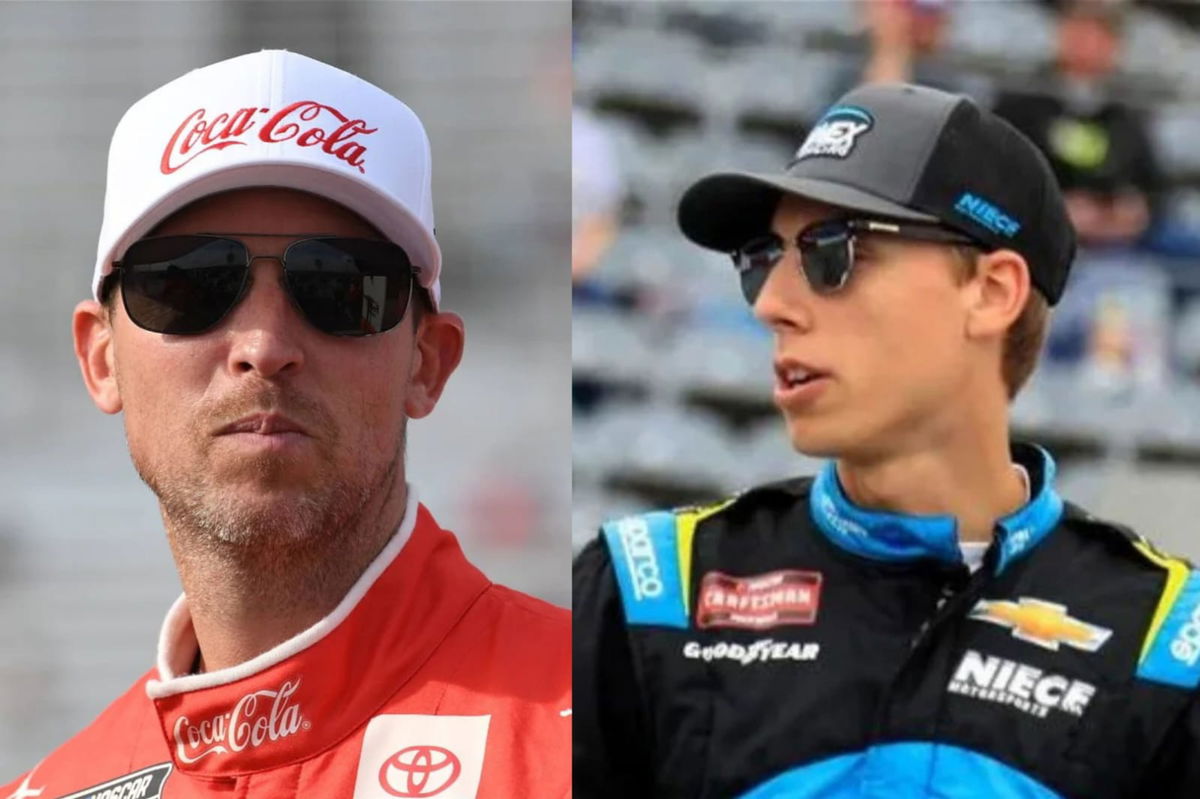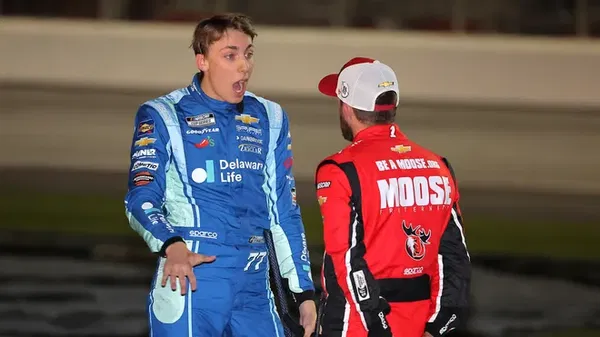
Imago
Image Credits: Imago

Imago
Image Credits: Imago
“I do thrive on it just simply because you feel like you’ve got 60,000 people that are rooting against you.” Denny Hamlin’s words post his Michigan victory reinforced the title he has heralded for two years. He surged from outside the top ten in the final 20 laps and toppled crowd-favorite William Byron on lap 197. After holding off Chris Buescher by just over a second and winning the race, Hamlin attracted a sea of boos from NASCAR’s grandstands – and he welcomed it.
Watch What’s Trending Now!
This iconic gesture fueled Denny Hamlin’s picture as the villain of NASCAR. He is not alone, as a young Carson Hocevar is also joining the picture. These new black hats of the sport may draw boos from fans, but they also ensure that people keep talking about them. Here is why they are more important than the heroes.
ADVERTISEMENT
Why we need ‘good’ NASCAR villains
For 76 years, NASCAR has thrilled fans to the core. But racing fans watch the sport not just for the fast cars. They watch it also for the best, charismatic drivers wreaking havoc on the racetrack. For instance, Darrell Waltrip became a villain because of his brash statements. Jeff Gordon may have looked like a chocolate boy racer, but he defeated seasoned veterans with ease, which rubbed many in the fan base the wrong way. Then came Kyle Busch in the 21st century – his aggressive racing style and arrogant post-race interviews ruffled many feathers. One thing was constant for all these seemingly black hats of the sport – they were brilliant drivers with multiple wins and championships. That is what makes them more popular than the rest of the drivers.
As Kyle Busch faces a long winless streak since June 2023, he has admittedly transferred his villain status to Denny Hamlin. The Joe Gibbs Racing veteran keeps fans on their toes whenever he picks up victories. After leading for 135 laps at the 2023 Bristol race, Hamlin had a big smile on his face when he responded to the fans’ boos: “I beat your favorite driver!” This bold defiance of what the majority perceives is what catapulted Hamlin to an iconic position. His unfiltered approach in podcasts and the courage to speak his mind also cement the ‘villain’ standing.
ADVERTISEMENT

ADVERTISEMENT
The same applies to Carson Hocevar, the Cup Series sophomore who has ticked off multiple veterans in 2025. Starting from Atlanta, where his aggressive moves enraged Kyle Busch, Ross Chastain, and Ryan Blaney and to Nashville where Hocevar intentionally ran Ricky Stenhouse Jr into the wall, the Spire driver’s questionable moves know no bounds.
Yet Carson Hocevar reminded Dale Earnhardt Jr the point of having villains like Hocevar or Hamlin. Dale Jr said, “It is important that this is f—-ng fun to watch.” He added, “You got to have the good guy, the villain, the F***up, you got to have the guy that just can’t f—ing get it right. You got to have the guy that’s stupid fast, but terrible decision maker. You need to have all these different people with all these different variables and throw them all in the buck. (Yeah, let them race). Put them in the cage and see what happens.”
What is more, Dale Jr also made a bold comparison to uphold Carson Hocevar. This may be the most historic story about Hocevar to date.
ADVERTISEMENT
Remembering none other than the legend himself
Granted, there have been many villains in NASCAR. But none have been as iconic as Dale Earnhardt Sr, the Intimidator himself. Amazon Prime recently explored the life of the 7-time Cup Series champion in the documentary ‘Earnhardt’. We got a lens into the not-so-pleasing aspects of Dale Sr’s career. That involved the willingness to wreck out his rivals as he did to Darrell Waltrip at the iconic 1986 Richmond race. A similar attitude is visible in Carson Hocevar, who is not afraid to ruffle a few feathers if it means giving his best to win a race or simply causing a sensation. He did it in an encounter with Corey Heim in the 2023 Craftsman Truck Series championship or his most recent bout with Ricky Stenhouse Jr.
Hence, Dale Earnhardt Jr compared the young rowdy racer to his father. The veteran said, “Carson…I think the guy reminds me of a 1979 Dale Earnhardt. Fast, not scared to use his front bumper, don’t care if somebody gets mad about it and on the verge of becoming a star. That’s exactly how I saw dad around that timeframe in his career.” Hocevar also responded to this bold comparison after the Michigan race. He said, “If I win seven championships, I would potentially call, want to — whatever. But, it’s obviously — if you’re gonna get compared to one guy, that’s the guy and endorsements from Dale Jr. Everybody.”
ADVERTISEMENT
Clearly, there are several pros to heralding the villains of the sport. Not only do they make great storylines, but they become legends carved into NASCAR’s history.
ADVERTISEMENT
ADVERTISEMENT
ADVERTISEMENT

